
The Conopidae, also known as the thick-headed flies, are a family of flies within the Brachycera suborder of Diptera, and the sole member of the superfamily Conopoidea. Flies of the family Conopidae are distributed worldwide in all the biogeographic realms except for the poles and many of the Pacific islands. About 800 species in 47 genera are described worldwide, about 70 of which are found in North America. The majority of conopids are black and yellow, or black and white, and often strikingly resemble wasps, bees, or flies of the family Syrphidae, themselves notable bee mimics. A conopid is most frequently found at flowers, feeding on nectar with its proboscis, which is often long.
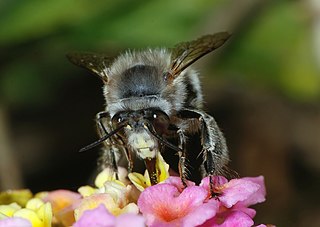
The bee genus Anthophora is one of the largest in the family Apidae, with over 450 species worldwide in 14 different subgenera. They are most abundant and diverse in the Holarctic and African biogeographic regions. All species are solitary, though many nest in large aggregations. Nearly all species make nests in the soil, either in banks or in flat ground; the larvae develop in cells with waterproof linings and do not spin cocoons. Males commonly have pale white or yellow facial markings, and/or peculiarly modified leg armature and hairs. Anthophora individuals can be distinguished from the very similar genus Amegilla by the possession of an arolium between the tarsal claws.

Anthophora ursina is a species of anthophorine bee in the family Apidae. It is found in North America.
Anthophora pacifica is a species of anthophorine bee in the family Apidae. It is found in North America.
Anthophora villosula, the Asian Shaggy Digger Bee, is a species of anthophorine bee in the family Apidae. It is presumably native to Asia but has been introduced in Maryland, where it has become established.

Dufourea marginata is a species of sweat bee in the family Halictidae. It is found in North America.

Physocephala sagittaria is a species of thick-headed fly in the family Conopidae. Larvae develop and pupate within the bodies of Bombus auricomus bees.

Physocephala tibialis is a species of thick-headed fly found throughout the eastern United States, often near flowering plants. The adult fly is primarily black with a yellow face and thin white stripes on the abdomen. It is commonly found along the east coast of the United States and is often found near flowering plants.
Physocephala texana is a species of thick-headed fly in the family Conopidae.
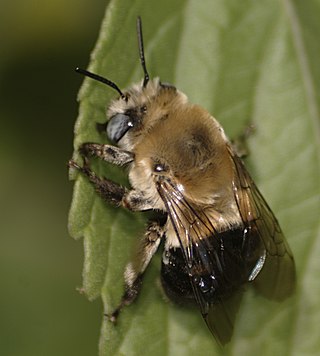
Anthophora montana is a species of anthophorine bee in the family Apidae. It is found in Central America and North America.

Anthophora californica is a species of anthophorine bee in the family Apidae. It is found in Central America and North America.
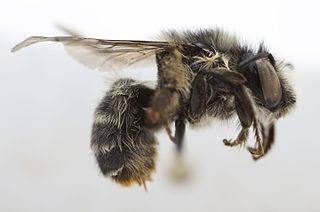
Anthophora terminalis is a species of anthophorine bee in the family Apidae. It is found in North America.
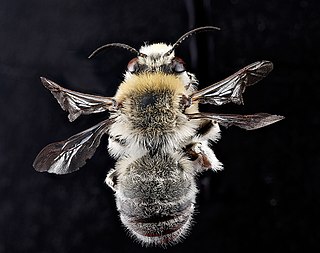
Anthophora occidentalis is a species of anthophorine bee in the family Apidae. It is found in North America.
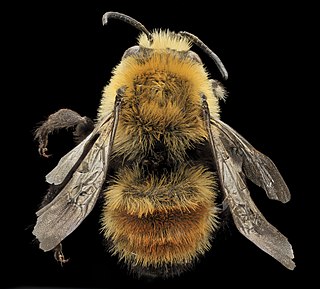
Anthophora bomboides is a species of anthophorine bee in the family Apidae. It is found in North America.
Anthophora centriformis is a species of anthophorine bee in the family Apidae. It is found in Central America and North America.
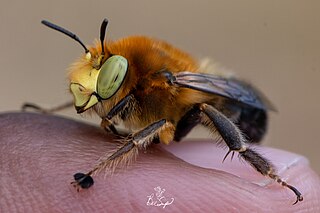
Anthophora crotchii is a species of anthophorine bee in the family Apidae named after George Robert Crotch. It is found in North America.
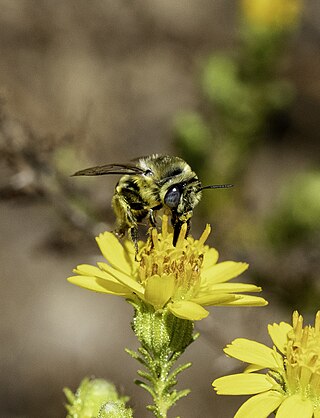
Anthophora urbana is a species of anthophorine bee in the family Apidae. It is found in Central America and North America.
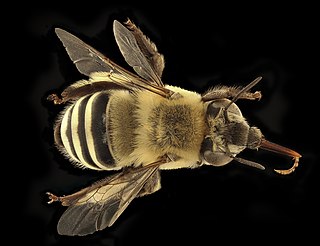
Anthophora walshii is a species of anthophorine bee in the family Apidae. It is found in North America.

Anthophora abrupta is a species of anthophorine bee in the family Apidae. It is found in North America. Females only mate once, while males can mate multiple times. This bee nests gregariously - when one female starts building a nest, others are attracted by her movements and pheromones.

Anthophora bimaculata is a species of bee.
















